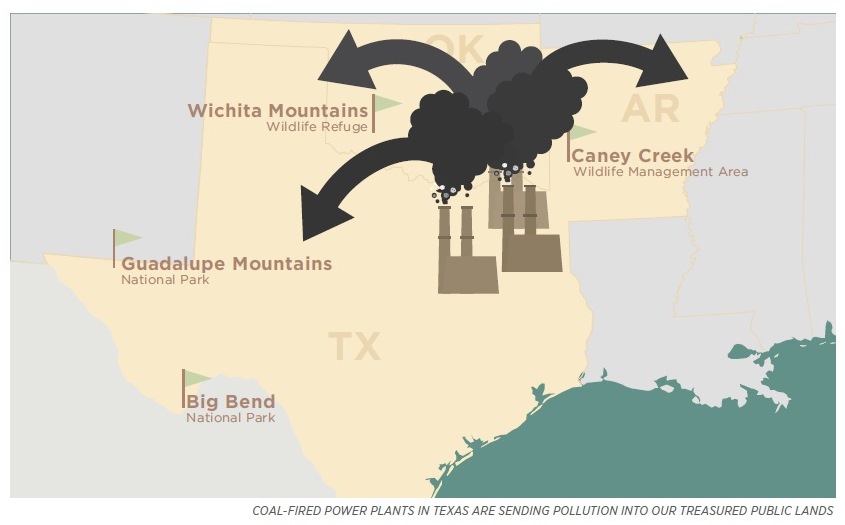The Big Bend National Park and Guadalupe Mountains National Park in west Texas are places people visit when they want to reconnect with nature and visit rugged landscapes that remind them of what the western United States was like before our massive cities and miles of highways. The dry air in these special lands sits on top of vibrant ecosystems and allows nighttime visitors to often get views of the Milky Way that are without competition anywhere in the world.
Unfortunately, in the 1970’s and 1980’s utilities in Texas started burning more and more coal to make electricity. In 2014 coal plants in Texas emitted more pollution than coal plants in any other state, and this pollution affects not only the health of local communities and the climate but also the million dollar views at American landmarks like the Big Bend. Tragically, this “haze” pollution also blows across state lines and it impacts wilderness areas in nearby states, like the Wichita Mountains National Wildlife Refuge in Oklahoma and the Caney Creek Wilderness Area in the Ouachita Mountains of western Arkansas.
 That's why hundreds of people are speaking out against Texas pollution at two public hearings in Texas and Oklahoma this week. The Environmental Protection Agency recently proposed a Regional Haze Plan to protect air quality at national parks in Texas and Oklahoma from this Texas pollution. Already thousands of people have submitted written comments to EPA asking them to make this a strong standard.
That's why hundreds of people are speaking out against Texas pollution at two public hearings in Texas and Oklahoma this week. The Environmental Protection Agency recently proposed a Regional Haze Plan to protect air quality at national parks in Texas and Oklahoma from this Texas pollution. Already thousands of people have submitted written comments to EPA asking them to make this a strong standard.
"Generations of Texas families and people from across the country and around the world have wondered at the rugged beauty of Big Bend. It’s truly a magical place," said Lon Bozarth, a property owner near Big Bend National Park. "But protecting the park isn't just about safeguarding our natural legacy. To me, it's about protecting my home and also the tourism that is vital to the local economy in West Texas."
I grew up just outside the Great Smoky Mountains National Park, so I know firsthand how much local economies in our nation’s most special places depended on clean, healthy air, so that visitors can enjoy majestic views and outdoor adventures that will have them coming back again. For those living in the backyards of these national treasures, their local economies depend on clean air, clean water, and a healthy environment.
Together, the new EPA standards for haze, carbon, and ozone pollution mean huge protections for the health of these communities. These protections will clean up our air and reduce pollution-related illness; millions of Americans with asthma and other respiratory ailments will breathe easier.
We know our opponents will be at these public hearings, too. They're pushing a do-nothing plan first proposed by the Texas Commission on Environmental Quality in 2009. That plan doesn't require coal plants to reduce any of their air pollution. It doesn't require the installation of a single scrubber by any of the coal plants in Texas. The do-nothing plan won't clear the skies over Big Bend until the Year 2155, over 140 years from now!
The EPA has stepped up with a better plan to address haze from Texas power plants. The rule will reduce haze pollution impacting Texas and Oklahoma national parks and wilderness areas by more than 228,000 tons of sulfur dioxide per year, which is almost two-thirds of the total amount of sulfur dioxide emitted by all of Texas's power plants. This is more sulfur dioxide than is emitted by the entire states of Michigan or Illinois or Florida.
If you're in Oklahoma City this Thursday, January 15, join us in speaking up for clean air. Or take action online here to tell the EPA you support the regional haze plan that will clear the air.
